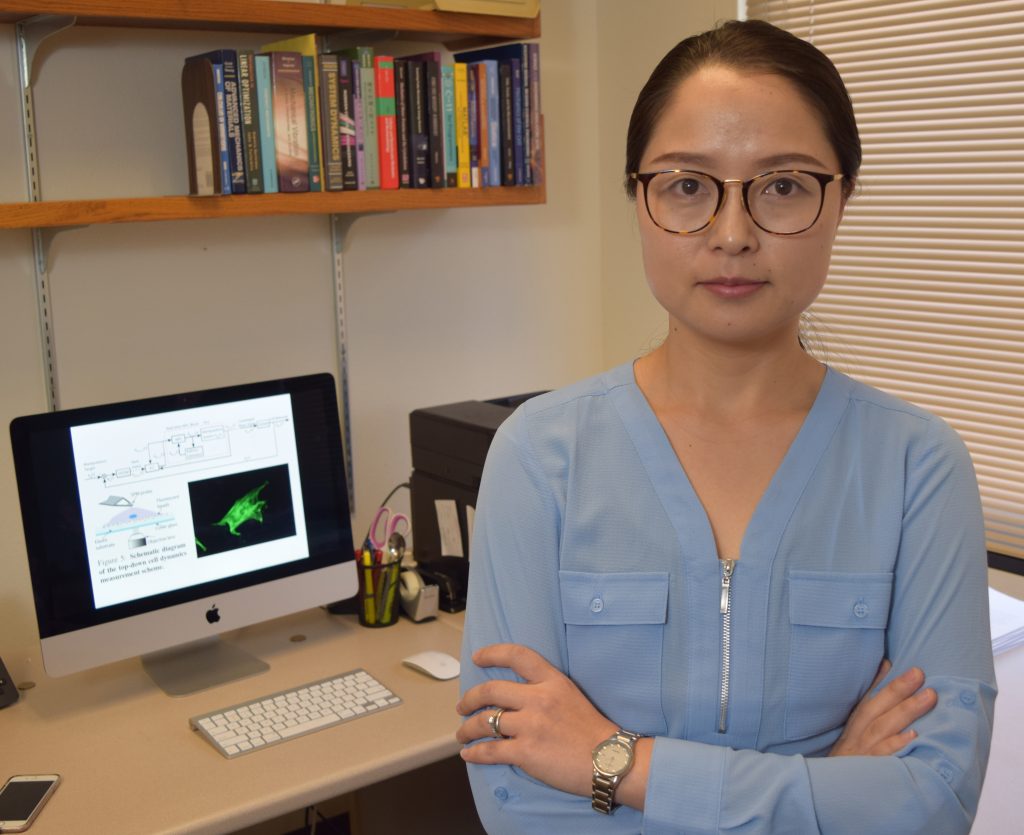
An upcoming research project by a mechanical engineering faculty member will study the dynamic mechanical behavior of live cells which might someday be used to help treat cancer.
Juan Ren, an assistant professor of mechanical engineering, recently received a CAREER award from the National Science Foundation (NSF). Ren was one of three ME researchers at Iowa State to receive this award, and was one of seven in the entire College of Engineering. The award will provide her with $500,000 over the next five years for her project entitled “Modeling and Control of Cellular Response to Dynamic Mechanical Manipulation Using a Dual-Input Platform.”
“The aim of this research is to develop a hardware as well as a control algorithm to study the dynamics of cell mechanical response, or what we call mechanotransduction,” said Ren. “The first step we need to do is invent a platform which can excite or disturb the cells using forces on both the top of the cells as well as the bottom where they grow. With this platform, which we call the dual-direction platform, we can observe if we excite the live cells from different directions, and how the structure of the cytoskeleton, which is the internal skeleton of the cells, will change in order to affect the cell’s mechanical response.”
Once Ren and her research team study this, the next step will be to use control approaches to manipulate the mechanical properties of cells to make them behave in a way mechanically that is good for tissue generation or other biomedical applications.
“This is an interesting topic and no one has looked at it extensively from the mechanical and controls point of view,” said Ren. “I’m junior faculty here and this was the first time I submitted an NSF CAREER proposal so I was pretty excited when I heard I won it.”
The primary application area for his project is for biomedical uses. From the medical point of view, Ren and her research team can use the outcome of this research to improve a medicine’s effectiveness. For example, they can study the most effective and efficient ways for cells to absorb the active components of a drug or protein.
Another direct product of this is that because they are studying the mechanical reorganization of the cytoskeleton and its dynamics, they can use the data and the model they build for biosynthesis approaches to build materials or structures which can synthesize the behavior or simulate the behavior of true cells or even at the tissue level.
More effective cancer treatment would be one potential outcome of this research. In general cancer cells are softer than normal cells, and because they are soft they are more flexible to migrate to affect other healthy tissues. Once Ren and her research team can control the growth of the cell or tissue they can target and eliminate the bad cells or tissues.
Ren added that this research extends beyond just biomedical applications for humans.
“With some modifications it can also be applied to veterinary medicine as well as plant cells, plant tissues, and soil to enhance the growth of an agriculture product,” Ren said.
While Ren’s research focus is on mechanical measurements and controls, she has worked with researchers in other areas who have provided their specific expertise. Meng Lu, who has dual appointments in ME as well as electrical and computer engineering and won the NSF CAREER award last year, penned a letter of support which Ren submitted along with her other application materials. She will also be working with colleagues from chemical and biological engineering as well as physics on this research, adding that this interdisciplinary collaboration will be “important to the success of the project.”
“For all of the biological phenomena, there are mechanical forces involved,” said Ren. “Typically, when people think about cells they think about the biological and chemical aspects, however, the mechanical forces generated during these processes are also a key factor, so that’s why as a mechanical engineering I was able to look at this issue.”
She added that the modeling she will use on this project will be similar to how mechanical engineers model other structures and forces like fluid and solid mechanics.
“Mechanical engineering is a framework and serves as a tool for us to solve problems that usually show up in other areas,” she said.
Eventually she said she hopes this project can also help to introduce the topic of nanomechanics or nanoscience to undergraduate students, even K-12 students through workshops, lab tours, mini seminars, and other outreach events.